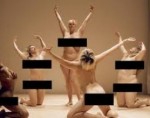Wish You Were Here: “Fresh Juice” Serves Up Age Old Questions In A New Vessel
by R. Eric Thomas
It was easy to imagine yourself on the stage of the Performance Garage at some point during “Fresh Juice”, a smartly-programmed evening of dances by Artists-in-Residence of the Mascher Space Co-op. A trio of probing, dramaturgically dense performances, “Fresh Juice” invited the audience to participate in the performance from the first moment they arrived and received a glass of the eponymous beverage. The delectable carrot-orange-banana concoction would not be the last gimmick employed to surprisingly charming effect that evening, though it would be the most easily digested.The 80-minute program started out on a quiet note, with Gregory Holt’s spare, introspective making claims. Dancer Kylin Mettler began the piece alone on-stage, perched bird-like on one folded leg and peering at the audience as Dusty Springfield’s “I Just Don’t Know What To Do With Myself” echoed off the walls. She was joined shortly thereafter by John Luna, who did not acknowledge her and, in a series of repeated phrases, darted and spun about the floor as if the top half of his body was being pulled by the lower half.
Apropos of nothing, Mettler began to speak. She told the audience of fall while climbing a cliff, at times mimicking gracefully by pulling her own leg from beneath her. Another voice, a male, broke into the largely soundless piece, relating parts of a story from which the point seemed to have been purposefully edited out. This is what was maddening about watching Holt’s curious piece: the connective tissue was being intentionally withheld. Though there were stories interpolated with the dancing, they eschewed any sort of narrative flow.
Mascher is to be commended for including thorough program notes for each dance and it’s here that making claims began to coalesce. It’s telling that Holt’s notes were three times as long as any other choreographers; he acknowledged the headiness of his chosen subject (kinesthetic empathies, by the way) and the limitations of the medium. His notes, which referenced Judith Butler and Susan Foster, were full of questions about the nature of storytelling, the ability of the body to convey meaning and the possibility of creating a common ground. The airy spaces between the two dancers , as well as between the content and the larger meaning, were filled with free associative thoughts, which may have been Holt’s intention. The choreographer asked much larger, heavier questions than his piece could support; making claims’s concerns are universal and endemic to the nature of being. Though his program notes were thought-provoking there simply wasn’t enough to grasp on to in the piece itself to illuminate the choreographer’s concerns. Holt deftly succeeded, however, in creating a portal through which the audience could venture further into the remaining dances.
Tori Lawrence’s Awakened Ruins, a site-specific dance created for Girard College and modified for the stage, was a lovely meditation on the disconnect between intention and action. Two, then three, dancers, caked with chalky power and leaving plumes of white dust in their wakes, trudged laboriously around the space in distinct sets. The dancers traversed the stage parallel to each other and later in unison. Their movements doubled and deflated, frustrating their progress. They were beckoned, it seemed, by violinist Christopher Brooks’ urgent composition. The music, vibrant and hopeful, was a marked contrast to lethargic movement phrases. As Brooks’ playing grew more frantic, suggesting drama, the dancers—Emily Herchenroeher, Ashley Lippolis, Pamela Vail—continued their slow journey with heavy limbs and sluggish feet. It is only when Lippolis’ stone creature broke free, stumbling and sliding around the space, that music and intention combined in service of a narrative. Lippolis tottered wildly like a newborn calf, then whirled, gasped and finally wandered off-stage toward the exit as the music grew reedy and high in a surprisingly tender development.
Gabrielle Revlock and Nicole Bindler’s exuberant, brash, crowd-pleasing, insidery, rambunctious I made this for you demands its own space. It was showy, it was sprawling, it literally blew the doors of the space open. What’s most fascinating, however,about Revlock and Bindler’s superbly constructed, intelligent piece is how well it meshed with the decidedly more subdued pieces that preceded it. I made this for you, its proverbial tongue superglued inside its proverbial cheek, initiated a conversation about what dance “is”—played as a hyper-literal spoken exchange between Revlock’s self described “experimental postmodern abstract” dancer and Bindler’s American Apparel-clad hipster. Bindler objected to Revlock’s loose-limbed, isolated movements, claiming that what she was doing was not dance. Or, I should say, Bindler’s character objected--with the heavy use of dialogue in this performance and its arch tone, the chasm opened up between each dancer and the character she was portraying, functions of the artifice. Aiming to please, Revlock’s character scampered off-stage and returned clutching a hula hoop. She galloped and twirled about the stage with a Toddlers in Tiaras-like air of desperation as Bindler looked on non-plussed, casually disrobed and proceeded to pour her limbs around the space with languid precision. Revlock’s character froze in a grimace that read shock, shame, anger and wonder. The dialogue ended: words failed on-stage as they do in this review and the artifice began to deconstruct itself with Charlie Kaufman-esque cleverness as the dancers descended into a rabbit hole of styles, intentions and meanings.
The piece vacillated wildly between madcap references and earnest contemplations, with equally varying results. At one point a panel of judges was brought on-stage for commentary, a rhetorical gesture both annoying and thought-provoking. Craig Peterson, of the Live Arts Brewery, rather hilariously deemed the piece a “vomitorium of styles” and “a dance apocalypse” with a level of snark that prompted one to wonder, “Is he playing a character, too?” Lisa Kraus, editor of this website, pointed out the potential disconnect. “There’s a piece of me that’s not sure how to look at the performance aspect,” she said. “Is it well-acted, for instance?” The query was left dangling, however, as Peterson took a cellphone call. For every step forward into an exploration of the larger intention, there was an equal step back into artifice. The latter increased in speed and frequency as the judges were quickly ushered off the stage and Revlock and Bindler commenced a series of sketches leading to their stunning final act. There was an prolonged sequence when Bindler French-kissed an audience member while Revlock presented a yoga dance with a partner; there was a trapeze artist, a poll of the audience, a b-girl, a wrestling match, roller skating. There was a moment when the piece broke open and dancers came out of the woodwork, tap-dancing, popping and locking, doing the salsa, capoeira and probably a dozen other kinds of physical performance. The circus-like atmosphere spilled out into the house and dancers cajoled audience members to abandon their seats, their introspection and join them as “Kids” by MGMT admonished “Take only what you need from it.
It didn't take a leap of imagination to see yourself on-stage at Mascher’s showy, heady “Fresh Juice,” and not only because that’s where the majority (though, curiously, not the entirety) of the audience ended up. Through experiments with form and content—and even redefinition—the evening of disparate, affecting pieces posed questions of being and belonging that lingered long after the impromptu dance party faded away.
“Fresh Juice” at the Performance Garage, October 13 & 15, 2011. No further performances.
By R. Eric Thomas
October 28, 2011









